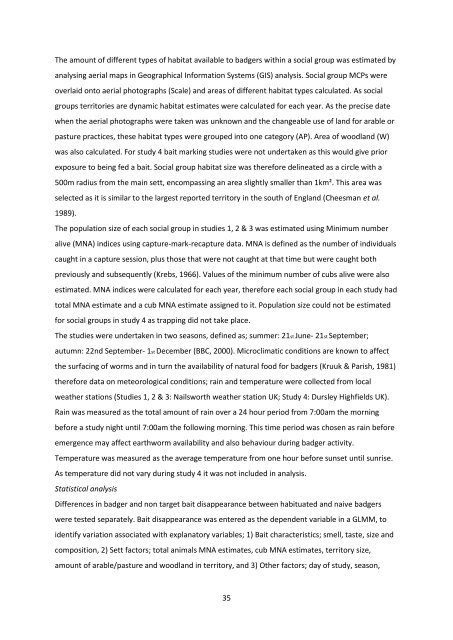Developing an oral bait for badger vaccination - Exeter Research ...
Developing an oral bait for badger vaccination - Exeter Research ...
Developing an oral bait for badger vaccination - Exeter Research ...
Create successful ePaper yourself
Turn your PDF publications into a flip-book with our unique Google optimized e-Paper software.
The amount of different types of habitat available to <strong>badger</strong>s within a social group was estimated by<br />
<strong>an</strong>alysing aerial maps in Geographical In<strong>for</strong>mation Systems (GIS) <strong>an</strong>alysis. Social group MCPs were<br />
overlaid onto aerial photographs (Scale) <strong>an</strong>d areas of different habitat types calculated. As social<br />
groups territories are dynamic habitat estimates were calculated <strong>for</strong> each year. As the precise date<br />
when the aerial photographs were taken was unknown <strong>an</strong>d the ch<strong>an</strong>geable use of l<strong>an</strong>d <strong>for</strong> arable or<br />
pasture practices, these habitat types were grouped into one category (AP). Area of woodl<strong>an</strong>d (W)<br />
was also calculated. For study 4 <strong>bait</strong> marking studies were not undertaken as this would give prior<br />
exposure to being fed a <strong>bait</strong>. Social group habitat size was there<strong>for</strong>e delineated as a circle with a<br />
500m radius from the main sett, encompassing <strong>an</strong> area slightly smaller th<strong>an</strong> 1km². This area was<br />
selected as it is similar to the largest reported territory in the south of Engl<strong>an</strong>d (Cheesm<strong>an</strong> et al.<br />
1989).<br />
The population size of each social group in studies 1, 2 & 3 was estimated using Minimum number<br />
alive (MNA) indices using capture-mark-recapture data. MNA is defined as the number of individuals<br />
caught in a capture session, plus those that were not caught at that time but were caught both<br />
previously <strong>an</strong>d subsequently (Krebs, 1966). Values of the minimum number of cubs alive were also<br />
estimated. MNA indices were calculated <strong>for</strong> each year, there<strong>for</strong>e each social group in each study had<br />
total MNA estimate <strong>an</strong>d a cub MNA estimate assigned to it. Population size could not be estimated<br />
<strong>for</strong> social groups in study 4 as trapping did not take place.<br />
The studies were undertaken in two seasons, defined as; summer: 21st June- 21st September;<br />
autumn: 22nd September- 1st December (BBC, 2000). Microclimatic conditions are known to affect<br />
the surfacing of worms <strong>an</strong>d in turn the availability of natural food <strong>for</strong> <strong>badger</strong>s (Kruuk & Parish, 1981)<br />
there<strong>for</strong>e data on meteorological conditions; rain <strong>an</strong>d temperature were collected from local<br />
weather stations (Studies 1, 2 & 3: Nailsworth weather station UK; Study 4: Dursley Highfields UK).<br />
Rain was measured as the total amount of rain over a 24 hour period from 7:00am the morning<br />
be<strong>for</strong>e a study night until 7:00am the following morning. This time period was chosen as rain be<strong>for</strong>e<br />
emergence may affect earthworm availability <strong>an</strong>d also behaviour during <strong>badger</strong> activity.<br />
Temperature was measured as the average temperature from one hour be<strong>for</strong>e sunset until sunrise.<br />
As temperature did not vary during study 4 it was not included in <strong>an</strong>alysis.<br />
Statistical <strong>an</strong>alysis<br />
Differences in <strong>badger</strong> <strong>an</strong>d non target <strong>bait</strong> disappear<strong>an</strong>ce between habituated <strong>an</strong>d naive <strong>badger</strong>s<br />
were tested separately. Bait disappear<strong>an</strong>ce was entered as the dependent variable in a GLMM, to<br />
identify variation associated with expl<strong>an</strong>atory variables; 1) Bait characteristics; smell, taste, size <strong>an</strong>d<br />
composition, 2) Sett factors; total <strong>an</strong>imals MNA estimates, cub MNA estimates, territory size,<br />
amount of arable/pasture <strong>an</strong>d woodl<strong>an</strong>d in territory, <strong>an</strong>d 3) Other factors; day of study, season,<br />
35
















